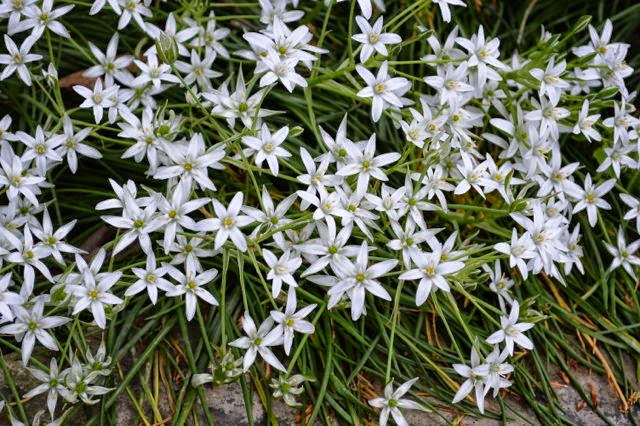| Star-of-Bethlehem (Ornithogalum umbellatum) looking dainty among some Hosta ‘Golden Tiara’ |
Sometimes you need plant thugs like the disarmingly pretty Star-of-Bethlehem (Ornithogalum umbellatum). A difficult spot (dry, maple-root-filled and shady, perhaps) might thank you for the toughness that brings on these bright spring flowers. Luckily, their enthusiasm has been held in check by the sandy, dry shade in my neighbour M’s garden next door. His aren’t the ones pictured here.
But beware, or at least aware, that even a few of these bulbs, given hospitable conditions, might insist they own the place; all of it – dangerous if you live near a wooded area where native plants could be throttled by their exuberant growth. Invasive alien plants and ravines make a bad combo.
W
mbicort online hiims.in/blog/wp-content/uploads/2024/08/jpg/symbicort.html no prescription pharmacy
ith other plants, I’ve certainly made the error of paying less attention to the second half of the mantra, “right plant, right place.” Lots of effort has been expended as I’ve tried to un-plant space invaders like common daylily (Hemerocallis fulva) and lily-of-the-valley (Convallaria majalis).
Perhaps we should coin a new saying to caution the unwary gardener, “Look before you reap.”
 |
| Star-of-Bethlehem is in the Asparagaceae family, and has quite a few surprising plant cousins – including Asparagus! |
 |
| Here it is, nudging its starry way through the landscape. Pretty, for sure. Pretty aggressive, too. |





12 comments
I've never intentionally introduced them into the garden, but they show up in the lawn now and then, pretty little starry blossoms.
Interesting how that happens, eh?
These should never be recommended
Awareness of the pros and (in this case, considerable) cons can help people make the right choices for their garden. We dry shade city gardeners, sited away from fragile wild spaces, might take a relativist view of dos and don'ts.
Would these be good in a small garden that is up against the house, mostly surrounded by a rock retainer wall (1 foot high), then an asphalt driveway on one side and a concrete walkway up to a wooden deck over bare earth?
Nothing else grows in the dirt under the stairs. The only exit is towards the stairs but it is ultra dry (weeds don't even grow there) as it is mostly kept dry under a wide eaves on a one story home. The garden is tear drop shaped (well sort of as it is up against a straight wall) and the "exit" is about 8 inches or so wide.
This sounds like a challenging spot for any plant. And remember that these bulbs are only spring blooming, so wouldn't bloom for more than a week or so. I wouldn't hazard anything there unless you're ready to annually amend the soil with organic matter, and pay regular attention to watering. Then choose plants for dry shade – but even these won't survive unless you're prepared to help them along.
I love how delicate these look but if invasive, I would rather plant something similar instead like native Gauras. Jan, are these beauties non-natives and aggressive?
Yes, they are non-natives and can certainly be aggressive. Although, as I've noted, in a really tough environment (like my nieghbour's sandy, maple-rooty, dry shade garden) they are held in check.
After looking for info online this morning on these gorgeous little jewels, it seems that they are extremely invasive and very hard to get rid off. Too bad, as I really, really would have loved to plant some of these in my garden. Maybe I will just plant some in containers and remove spent flowers to minimize risk of it escaping into my garden. Beautiful little devil…. just so gorgeous and delicate looking.
Planting them in containers might be a good strategy. Deadheading, especially.
I'm in the woods of NH so planting them is my garden is totally out of the question; but placing these beauties in a container and diligent deadheading might (???) be the way to go. Darn! These are such tempting little flowers!
Hmmm, if you live deep in the woodlands, even putting them in containers might not be a good idea. It's impressive what "good gardeners" ground-digging animals like squirrels can be. I've had unusual tulips transplanted by squirrels all down my city block. So it's probably best to resist the temptation. Lots of other great plants to use!